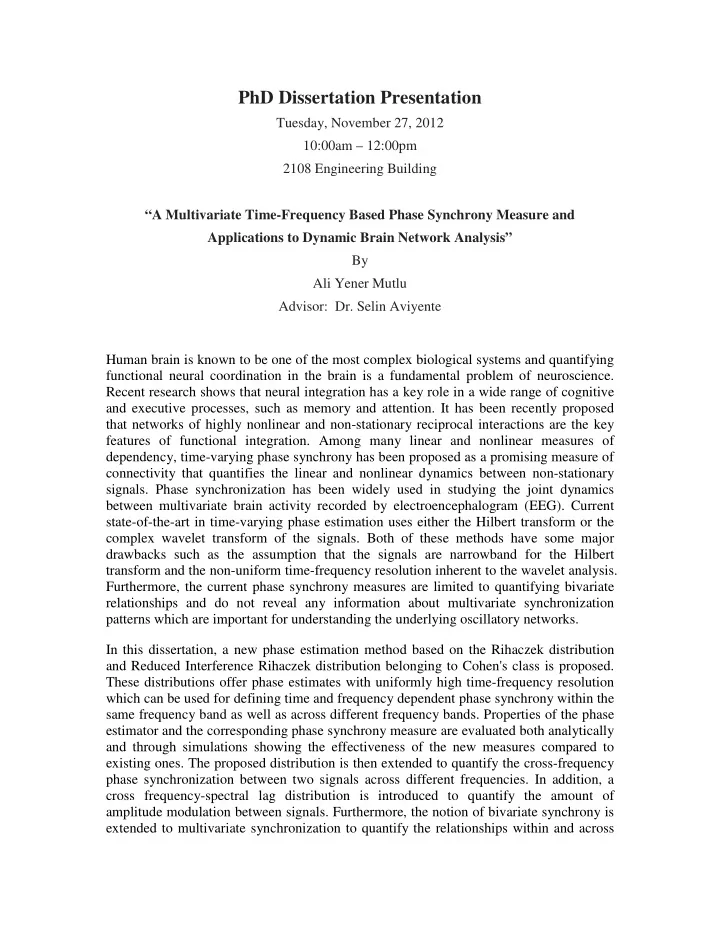

PhD Dissertation Presentation Tuesday, November 27, 2012 10:00am – 12:00pm 2108 Engineering Building “A Multivariate Time-Frequency Based Phase Synchrony Measure and Applications to Dynamic Brain Network Analysis” By Ali Yener Mutlu Advisor: Dr. Selin Aviyente Human brain is known to be one of the most complex biological systems and quantifying functional neural coordination in the brain is a fundamental problem of neuroscience. Recent research shows that neural integration has a key role in a wide range of cognitive and executive processes, such as memory and attention. It has been recently proposed that networks of highly nonlinear and non-stationary reciprocal interactions are the key features of functional integration. Among many linear and nonlinear measures of dependency, time-varying phase synchrony has been proposed as a promising measure of connectivity that quantifies the linear and nonlinear dynamics between non-stationary signals. Phase synchronization has been widely used in studying the joint dynamics between multivariate brain activity recorded by electroencephalogram (EEG). Current state-of-the-art in time-varying phase estimation uses either the Hilbert transform or the complex wavelet transform of the signals. Both of these methods have some major drawbacks such as the assumption that the signals are narrowband for the Hilbert transform and the non-uniform time-frequency resolution inherent to the wavelet analysis. Furthermore, the current phase synchrony measures are limited to quantifying bivariate relationships and do not reveal any information about multivariate synchronization patterns which are important for understanding the underlying oscillatory networks. In this dissertation, a new phase estimation method based on the Rihaczek distribution and Reduced Interference Rihaczek distribution belonging to Cohen's class is proposed. These distributions offer phase estimates with uniformly high time-frequency resolution which can be used for defining time and frequency dependent phase synchrony within the same frequency band as well as across different frequency bands. Properties of the phase estimator and the corresponding phase synchrony measure are evaluated both analytically and through simulations showing the effectiveness of the new measures compared to existing ones. The proposed distribution is then extended to quantify the cross-frequency phase synchronization between two signals across different frequencies. In addition, a cross frequency-spectral lag distribution is introduced to quantify the amount of amplitude modulation between signals. Furthermore, the notion of bivariate synchrony is extended to multivariate synchronization to quantify the relationships within and across
groups of signals. Measures of multiple correlation and complexity are used as well as a more direct multivariate synchronization measure, `Hyperspherical Phase Synchrony', is proposed. This new measure is based on computing pairwise phase differences to create a multidimensional phase difference vector and mapping this vector to a high dimensional space. Hyperspherical phase synchrony offers lower computational complexity and improved performance in terms of robustness to noise compared to the existing measures. Finally, a subspace analysis framework is proposed for studying time-varying evolution of functional brain connectivity. The proposed subspace analysis approach identifies event intervals accounting for the underlying neurophysiological events and extracts key graphs for describing the particular intervals with minimal redundancy. Results from the application to EEG data indicate the effectiveness of the proposed framework in determining the event intervals and summarizing brain activity with a few number of representative graphs. PUBLICATIONS AND CONFERENCE PROCEEDINGS Journals: • Ali Yener Mutlu, Edward Bernat, and Selin Aviyente, “A Signal-Processing- Based Approach to Time-Varying Graph Analysis for Dynamic Brain Network Identification,” Computational and Mathematical Methods in Medicine , vol. 2012, Article ID 451516, 2012. • S. Aviyente and A. Mutlu, “A Time-Frequency Based Approach to Phase and Phase Synchrony Estimation,” IEEE Transactions on Signal Processing , vol. 59, no. 7, pp. 3086-3098, July, 2011. • M. Ali Yener and A. Selin, “Multivariate Empirical Mode Decomposition for Quantifying Multivariate Phase Synchronization,” EURASIP Journal on Advances in Signal Processing , vol. 2011, 2011. Conference Proceedings: • A. Mutlu and S. Aviyente, “Extraction of key graphs using subspace analysis for dynamic functional brain networks,” submitted to IEEE International Conference on Acoustics, Speech and Signal Processing (ICASSP) , May 2013. • A. Mutlu and S. Aviyente, “Hyperspherical phase synchrony for quantifying global synchrony in the brain,” submitted to IEEE International Conference on Acoustics, Speech and Signal Processing (ICASSP) , May 2013. • A. Mutlu and S. Aviyente, “Hyperspherical phase synchrony for quantifying multivariate phase synchronization,” in IEEE Statistical Signal Processing Workshop (SSP) , Aug. 2012, pp. 888–891.
• A. Mutlu and S. Aviyente, “Dynamic network summarization using convex optimization,” in IEEE Statistical Signal Processing Workshop (SSP) , Aug. 2012, pp. 117–120. • A. Mutlu and S. Aviyente, “Joint frequency spectral lag representation for cross- frequency modulation analysis in the brain,” in IEEE International Conference on Acoustics, Speech and Signal Processing (ICASSP) , May 2011, pp. 3800–3803. • M. Bolanos, A. Mutlu, S. Aviyente, and E. Bernat, “Identifying multivariate EEG synchronization networks through multiple subject community detection,” in Asilomar Conference on Signals, Systems and Computers (ASILOMAR) , Nov. 2011, pp. 122–126. • A.Y. Mutlu and S. Aviyente, “Comparison of nonparametric and parametric time- varying methods for quantifying phase synchrony,” in Asilomar Conference on Signals, Systems and Computers (ASILOMAR) , Nov. 2010, pp. 1991–1995. • A. Mutlu and S. Aviyente, “Inferring effective connectivity in the brain from eeg time series using dynamic Bayesian networks,” in Annual International Conference of the IEEE Engineering in Medicine and Biology Society (EMBC) , 2009, pp. 4739–4742.
Recommend
More recommend